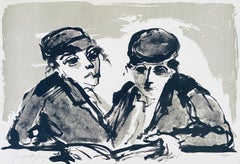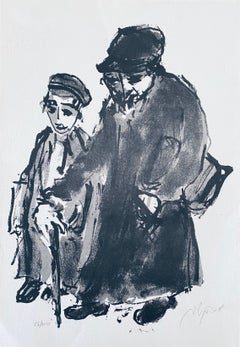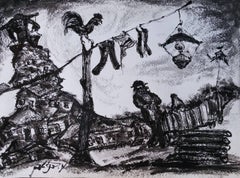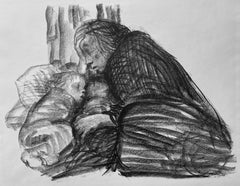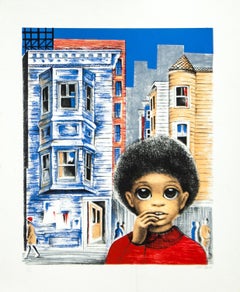Moshe Bernstein Art
to
5
3
2
4
1
Overall Height
to
Overall Width
to
4
1
5
4
3
2
2
1
1
5
1
5
6,961
3,321
2,514
1,213
4
1
Artist: Moshe Bernstein
Polish Israeli Artist Expressionist Hand Signed Lithograph
By Moshe Bernstein
Located in Surfside, FL
Born in Poland in 1920, Bernstein completed his art studies in the Academy of Vilna in 1939. His family was wiped out in the Holocaust, but he survived the war and lived in Russia until 1947, when he immigrated to Palestine as part of the "illegal immigration" (aliyah bet). He was caught and spent time in a detention camp in Cyprus.
Bernstein's artistic path in Israel recalls that of other painters who reflected their memories of small Jewish Diaspora towns, or shtetls. At a certain stage, these artists were rejected by the local art scene. In the 1950s, '60s and '70s, the subject aroused public interest and recognition. In 1948, Bernstein participated in a group exhibit in the Tel Aviv Museum of Art, and in 1949 in a group exhibit at Artists' House (then known as the Artists' Pavilion). In 1954, he participated in another exhibition - of young artists - in the Tel Aviv Museum. In 1962, he had a solo exhibition at the Tel Aviv Museum, another in 1967 at the Haifa Museum, and a retrospective in 1973 in the Ein Harod Museum of Art. Interspersed among these events were shows at the Katz and Chemerinsky Galleries in Tel Aviv.
A Bernstein exhibit, which included paintings of the shtetl, was shown in 1998 at the international theater festival in Parma, Italy. In 1999, he was awarded a prize by the Massuah Institute for the Study of the Holocaust, for his "documentation of the world that vanished at the beginning of his career."
His paintings appeared on the walls of the defunct Kassit cafe in Tel Aviv, and in the Kiton restaurant - "places in which he ate...
Category
Mid-20th Century Expressionist Moshe Bernstein Art
Materials
Lithograph
Polish Israeli Artist Expressionist Hand Signed Lithograph
By Moshe Bernstein
Located in Surfside, FL
Born in Poland in 1920, Bernstein completed his art studies in the Academy of Vilna in 1939. His family was wiped out in the Holocaust, but he survived the war and lived in Russia until 1947, when he immigrated to Palestine as part of the "illegal immigration" (aliyah bet). He was caught and spent time in a detention camp in Cyprus.
Bernstein's artistic path in Israel recalls that of other painters who reflected their memories of small Jewish Diaspora towns, or shtetls. At a certain stage, these artists were rejected by the local art scene. In the 1950s, '60s and '70s, the subject aroused public interest and recognition. In 1948, Bernstein participated in a group exhibit in the Tel Aviv Museum of Art, and in 1949 in a group exhibit at Artists' House (then known as the Artists' Pavilion). In 1954, he participated in another exhibition - of young artists - in the Tel Aviv Museum. In 1962, he had a solo exhibition at the Tel Aviv Museum, another in 1967 at the Haifa Museum, and a retrospective in 1973 in the Ein Harod Museum of Art. Interspersed among these events were shows at the Katz and Chemerinsky Galleries in Tel Aviv.
A Bernstein exhibit, which included paintings of the shtetl, was shown in 1998 at the international theater festival in Parma, Italy. In 1999, he was awarded a prize by the Massuah Institute for the Study of the Holocaust, for his "documentation of the world that vanished at the beginning of his career."
His paintings appeared on the walls of the defunct Kassit cafe in Tel Aviv, and in the Kiton restaurant - "places in which he ate...
Category
Mid-20th Century Expressionist Moshe Bernstein Art
Materials
Lithograph
Polish Israeli Artist Expressionist Hand Signed Lithograph
By Moshe Bernstein
Located in Surfside, FL
Born in Poland in 1920, Bernstein completed his art studies in the Academy of Vilna in 1939. His family was wiped out in the Holocaust, but he survived the war and lived in Russia until 1947, when he immigrated to Palestine as part of the "illegal immigration" (aliyah bet). He was caught and spent time in a detention camp in Cyprus.
Bernstein's artistic path in Israel recalls that of other painters who reflected their memories of small Jewish Diaspora towns, or shtetls. At a certain stage, these artists were rejected by the local art scene. In the 1950s, '60s and '70s, the subject aroused public interest and recognition. In 1948, Bernstein participated in a group exhibit in the Tel Aviv Museum of Art, and in 1949 in a group exhibit at Artists' House (then known as the Artists' Pavilion). In 1954, he participated in another exhibition - of young artists - in the Tel Aviv Museum. In 1962, he had a solo exhibition at the Tel Aviv Museum, another in 1967 at the Haifa Museum, and a retrospective in 1973 in the Ein Harod Museum of Art. Interspersed among these events were shows at the Katz and Chemerinsky Galleries in Tel Aviv.
A Bernstein exhibit, which included paintings of the shtetl, was shown in 1998 at the international theater festival in Parma, Italy. In 1999, he was awarded a prize by the Massuah Institute for the Study of the Holocaust, for his "documentation of the world that vanished at the beginning of his career."
His paintings appeared on the walls of the defunct Kassit cafe in Tel Aviv, and in the Kiton restaurant - "places in which he ate...
Category
Mid-20th Century Expressionist Moshe Bernstein Art
Materials
Lithograph
Polish Israeli Artist Expressionist Hand Signed Lithograph
By Moshe Bernstein
Located in Surfside, FL
Born in Poland in 1920, Bernstein completed his art studies in the Academy of Vilna in 1939. His family was wiped out in the Holocaust, but he survived the war and lived in Russia un...
Category
Mid-20th Century Expressionist Moshe Bernstein Art
Materials
Lithograph
Memories of the Shtetl (Jewish Village)
By Moshe Bernstein
Located in New York, NY
Signed in Hebrew, painted circa 1970
Category
1970s Modern Moshe Bernstein Art
Materials
Ink
Related Items
STADTISCHES OBDACH (Urban Shelter)
By Käthe Kollwitz
Located in Santa Monica, CA
KATHE KOLLWITZ (German 1867 -1945)
STADTISCHES OBDACH (Urban Shelter) 1926 (Knesebeck 226, Klipstein 219.bB),
Lithograph from the unsigned edition for the annual edition of the Kuns...
Category
1920s Expressionist Moshe Bernstein Art
Materials
Lithograph
Boy in Red Shirt original lithograph by Margaret Keane c 1980
By Margaret Keane
Located in Paonia, CO
Boy in Red Shirt is an original lithograph by Margaret Keane c. 1980. A young boy in a red shirt is seen in front of a three story building in a city on a blue sky day. An original color lithograph limited edition 72/100 and signed in pencil by the artist. In very good condition with artist's stamp in bottom left corner and a faint line from the figure's hand that goes 2 inches towards bottom margin. Can be seen in detail photo. Could have happened when printed.
Margaret Keane born Peggy Doris Hawkins on September 15, 1927 in Nashville, Tennessee. When she was two her eardrum was permanently damaged during a mastoid operation. Unable to hear properly she learned to watch the eyes of the person talking to her to understand them. Keane started drawing as a child and at age 10 she took classes at the Watkins Institute in Nashville. Keane painted her first oil painting of two little girls one crying and one laughing when she was 10 years old and gave the drawing to her grandmother. She was well known at the local church for her sketches of angels...
Category
1980s Expressionist Moshe Bernstein Art
Materials
Lithograph
GEFALLEN (Killed in Action)
By Käthe Kollwitz
Located in Santa Monica, CA
KATHE KOLLWITZ (1867-1945)
GEFALLEN (Killed in Action) 1920 (Klipstein 153 (1st state, a of c of 2 states)
Lithograph on laid paper. Image 16 ¼ x 15 ¼ inches, Large Full Sheet, 25 ½...
Category
1920s Expressionist Moshe Bernstein Art
Materials
Lithograph
BLACK FACE
By Karel Appel
Located in Santa Monica, CA
KAREL APPEL (1921 - 2006)
BLACK FACE, 1969
Lithograph in colors signed in pencil. Edition 26/75, Image: 19 3/4 x 25 1/4, sheet: 22 x 30 inches. Just hint of a mat line
Appel was a member of the Cobra art movement
Category
1960s Expressionist Moshe Bernstein Art
Materials
Lithograph
Mejdel Yaba
By James McBey
Located in Storrs, CT
Mejdel Yaba. 20 September, 1918 Pencil, ink and watercolour on paper. 8 1/8 x 22. Provenance: The Fine Art Society. Annotated, upper left, "due N at ???' Dated on the ink drawing on ...
Category
Early 20th Century Modern Moshe Bernstein Art
Materials
Watercolor, Ink
Basilica of the Sacred Heart of Paris - Original Drawing - 20th century
Located in Roma, IT
Basilica of the Sacred Heart of Paris is an original drawing in China ink and felt tip pen on cardboard realized in 1950ca. by an Anonymous artist of the XX century.
The State of p...
Category
20th Century Modern Moshe Bernstein Art
Materials
Ink, Felt Pen
H 11.03 in W 14.18 in D 0.08 in
Louis Osman FRIBA Thomas Lumley Castle architectural sketches c. 1960s
By Louis Osman
Located in London, GB
As Goldsmith Osman designed the Crown for the Investiture of the Prince of Wales in 1969, and as architect he commissioned Jacob Epstein's chef d'oeuvre, the Madonna and Child on the...
Category
Mid-20th Century Modern Moshe Bernstein Art
Materials
Watercolor, Pen, Ink
Rettung - Original Lithograph by Alfred Kubin - 1944
By Alfred Kubin
Located in Roma, IT
This artwork is shipped from Italy. Under existing legislation, any artwork in Italy created over 70 years ago by an artist who has died requires a licence for export regardless of t...
Category
1940s Expressionist Moshe Bernstein Art
Materials
Lithograph
H 15.36 in W 19.69 in D 0.04 in
Whimsical Fishing Illustration Cartoon 1938 Mt Tremblant Ski Lodge William Steig
By William Steig (b.1907)
Located in Surfside, FL
Lighthearted Illustration of Outdoor Pursuits This one of a fisherman signed "W. Steig"
Provenance: from Mrs. Joseph B. Ryan, Commissioned by Joe Ryan for the bar at his ski resort, Mount Tremblant Lodge, in 1938.
Mont Tremblant, P.Q., Canada
Watercolor and ink on illustration board, sights sizes 8 1/2 x 16 1/2 in., framed.
In 1938 Joe Ryan, described as a millionaire from Philadelphia, bushwhacked his way to the summit of Mont Tremblant and was inspired to create a world class ski resort at the site. In 1939 he opened the Mont Tremblant Lodge, which remains part of the Pedestrian Village today. This original illustration is on Whatman Illustration board. the board measures 14 X 22 inches. label from McClees Galleries, Philadelphia, on the frame backing paper.
William Steig, 1907 – 2003 was an American cartoonist, sculptor, and, in his later life, an illustrator and writer of children's books. Best known for the picture books Sylvester and the Magic Pebble, Abel's Island, and Doctor De Soto, he was also the creator of Shrek!, which inspired the film series of the same name. He was the U.S. nominee for both of the biennial, international Hans Christian Andersen Awards, as a children's book illustrator in 1982 and a writer in 1988.
Steig was born in Brooklyn, New York in 1907, and grew up in the Bronx. His parents were Polish-Jewish immigrants from Austria, both socialists. His father, Joseph Steig, was a house painter, and his mother, Laura Ebel Steig, was a seamstress who encouraged his artistic leanings. As a child, he dabbled in painting and was an avid reader of literature. Among other works, he was said to have been especially fascinated by Pinocchio.He graduated from Townsend Harris High School at 15 but never completed college, though he attended three, spending two years at City College of New York, three years at the National Academy of Design and a mere five days at the Yale School of Fine Arts before dropping out of each.
Hailed as the "King of Cartoons" Steig began drawing illustrations and cartoons for The New Yorker in 1930, producing more than 2,600 drawings and 117 covers for the magazine. Steig, later, when he was 61, began writing children's books. In 1968, he wrote his first children's book. He excelled here as well, and his third book, Sylvester and the Magic Pebble (1969), won the Caldecott Medal. He went on to write more than 30 children's books, including the Doctor DeSoto series, and he continued to write into his nineties. Among his other well-known works, the picture book Shrek! (1990) formed the basis for the DreamWorks Animation film Shrek (2001). After the release of Shrek 2 in 2004, Steig became the first sole-creator of an animated movie franchise that went on to generate over $1 billion from theatrical and ancillary markets after only one sequel. Along with Maurice Sendak, Saul Steinberg, Ludwig Bemelmans and Laurent de Brunhofff his is one of those rare cartoonist whose works form part of our collective cultural heritage.
In 1984, Steig's film adaptation of Doctor DeSoto directed by Michael Sporn was nominated for the Academy Award for Best Animated Short Film. As one of the most admired cartoonists of all time, Steig spent seven decades drawing for the New Yorker magazine. He touched generations of readers with his tongue–in–cheek pen–and–ink drawings, which often expressed states of mind like shame, embarrassment or anger. Later in life, Steig turned to children's books, working as both a writer and illustrator.
Steig's children's books were also wildly popular because of the crazy, complicated language he used—words like lunatic, palsied, sequestration, and cleave. Kids love the sound of those words even if they do not quite understand the meaning. Steig's descriptions were also clever. He once described a beached whale as "breaded with sand."
Throughout the course of his career, Steig compiled his cartoons and drawings into books. Some of them were published first in the New Yorker. Others were deemed too dark to be printed there. Most of these collections centered on the cold, dark psychoanalytical truth about relationships. They featured husbands and wives fighting and parents snapping at their kids. His first adult book, Man About Town, was published in 1932, followed by About People, published in 1939, which focused on social outsiders. Sick of Each Other, published in 2000, included a drawing depicting a wife holding her husband at gunpoint, saying, "Say you adore me."
According to the Los Angeles Times, fellow New Yorker artist...
Category
1930s American Modern Moshe Bernstein Art
Materials
India Ink, Watercolor, Illustration Board
Into the Woods - China Ink and Watercolor by G. Kayser - 1948
Located in Roma, IT
Into the Woods is an original modern artwork realized by the French artist Gabrielle Kayser in 1948.
Original watercolored and china ink on paper.
Hand-signed and dated by the ar...
Category
1940s Modern Moshe Bernstein Art
Materials
Watercolor, Ink
H 11.62 in W 8.47 in D 0.08 in
Gathering Vraic on a Jersey Shore.
By Edmund Blampied
Located in Storrs, CT
Gathering Vraic on a Jersey Shore. c. 1937. Ink and watercolor on 'Castle Linen Tolli & Harvey LD London' countermarked paper. 7 1/8 x 13 1/2 (sheet 12 1/2 x 16 1/4). Good condition, apart from small professionally repaired paper losses at the corners, from previous hinges. Dedicated 'To my friend Harold James Bailey E.B.' and annotated 'To wish you a glad glow of happiness for Christmas and the New Year'. From the collection of the famous Blampied scholar and collector, Harold J. Bailey, who wrote an article, 'Edmund Blampied: Artist and Philosopher' in the Print Collector's Quarterly 24 (1937). Housed in a 15 1/2 x 21 1/2-inch Whistler style gold wood frame.
In the left rear section is a Martello or Conway tower, built as a fortiffiction. A Jersey Round Tower Coastal towers stand all along the coast of the island. The British built 22 round towers, one similar square tower, and eight Martello towers towards the end of the 18th Century and in the early to mid-19th Century, but now only 24 remain, including seven of the Martellos.
Vraic is a seaweed found in the Channel Islands. The main use of vraic is for spreading over potato fields during the winter. It is then ploughed into the soil before the potatoes are planted in late winter and spring. Vraic was traditionally gathered by horse and cart in Grouville Bay and St Ouen's Bay, and in smaller quantities at Le Hocq and Havre des Pas. The practice continues using...
Category
1930s Modern Moshe Bernstein Art
Materials
Ink, Watercolor
Corrupt Petliura Ukraine Russian Propaganda Poster
Located in Paonia, CO
Vintage Soviet Government propaganda lithographic poster titled with Ukrainian text that reads “Corrupt Petliura has sold Ukraine to the Polish landowners. Landowners burned and plundered Ukraine. Death to landowners and Petlyurovites.” Originally issued April 1920 following the Treaty of Warsaw (also the Polish-Ukrainian Agreement). The agreement was a military-economical alliance between the Second Polish Republic, represented by Jozef Pilsudski, and the Ukrainian People’s Republic, represented by Symon Petliura, against Bolshevik Russia. The artwork features Jozef Pilsudski running away with a sack of goods. Good condition. Artist unknown.
The Bolshevik Era (1917-1921) was a life and death struggle for the Bolsheviks and their ideology. The propaganda poster...
Category
Early 20th Century Expressionist Moshe Bernstein Art
Materials
Lithograph
Moshe Bernstein art for sale on 1stDibs.
Find a wide variety of authentic Moshe Bernstein art available for sale on 1stDibs. You can also browse by medium to find art by Moshe Bernstein in lithograph, ink and more. Much of the original work by this artist or collective was created during the 20th century and is mostly associated with the Expressionist style. Not every interior allows for large Moshe Bernstein art, so small editions measuring 14 inches across are available. Customers who are interested in this artist might also find the work of Arthur Kolnik, Jacob Pins, and Frank Kleinholz. Moshe Bernstein art prices can differ depending upon medium, time period and other attributes. On 1stDibs, the price for these items starts at $400 and tops out at $1,100, while the average work can sell for $400.

